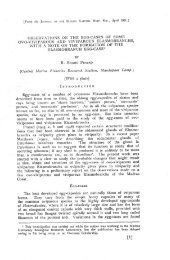PDF - Eprints@CMFRI
PDF - Eprints@CMFRI
PDF - Eprints@CMFRI
Create successful ePaper yourself
Turn your PDF publications into a flip-book with our unique Google optimized e-Paper software.
7<br />
rung von Korallenriffen bei Aqaba" (1974), that is on the Jordania n side of the Gulf near the 197 3 founded<br />
Marine Science Station south of the town of Aqaba. The work also contains a list of the found corals.<br />
These investigations were supplemented by H. MERGNER & A. SVOBODA (1977) with eco-functional<br />
analyses of seasonal changes in the population of reef organisms and biological productivity measurements.<br />
Finally a detailed quantitative analysis of a reef lagoon area 5 by 5 metres was carried out (H. MERGNER ,<br />
1979), followed by the investigation of the coral community of a fore reef area 5 by 5 metres in a depth<br />
of 10 to 12 metres (H. MERG ER & H. SC HUHMACHER, 1981). A part of the corals found there were<br />
given to one of us (Sch.) for identification, some of them are mentioned in the present report.<br />
On the invitation of the Jordania n Government a French group , led by M. PICHON and J . JAUBERT ,<br />
worked at the young and still incomplete Marine Science Station near Aqaba in 1978. The Science Reports<br />
of the group which have not been published yet, contain the results of the coral reef studies and a first<br />
inventory of the corals livi ng there.<br />
In 1977 and 1979 the "Saudi-Sudanese Commi ssion for the Exploitation of the Red Sea Resources"<br />
together with PREUSSAG , Hannover (Fed . Rep. Germany), made [wo expeditions, Meseda I and II ,<br />
to investigate metal-containing sediments in the Atlantis-II -Deep in the central Red Sea (Metalliferous<br />
Sediments Atlantic-II -Deep). A further aim was to find out by means of ecological investigations how<br />
damage through sea pollution could be avoided when exploiting the sediments. As part of these investigations<br />
the benthos was explored and some corals were gathered which, however, are not yet evaluated. A<br />
first report on these Meseda I and II cruises was published by H. TH IEL (1980).<br />
Si nce 197 1 Hans W. FRICKE of the Max Planck Institut fur Verhaltensphysiologie in Seewiesen has<br />
worked on animal behaviour in the Gulf of Aqaba. His observations, especially on fish but also on shrimps,<br />
brittle stars, sea urchins, crinoids and sea anemones resulted in numerous puplications. He summarized<br />
many of his experiences in his book "Bericht aus dem Riff" (1976). But all investigations in a coral reef<br />
suffer from the fact that the length of stay under water with aqualungs is limited, whereas the surfacing<br />
periods are disproportionately long due to the decompression. This can be improved considerably when<br />
the diver can live under water. Therefore FRICKE built the underwater house " eritica" , which proved<br />
to be an important instrument for the exploration of coral reefs. In April 1978 FR ICKE 's underwaterhou<br />
e was placed on a coral reef 10 m deep near Eilat in the Gulf of Aqaba, and in Juni 1978 the first<br />
12-day diving excursion was carried through. In 1978 and 1979 FRICKE reported on the " Neritica", and<br />
in 1980 on "Control of different mating systems in a coral reef fish . . . " by experimental alteration of<br />
the size of the Stylophora coral habitat. A treatise of H. FRICKE & E. VARESCHI on the "bubbles" of<br />
Plerogyra sinuosa as photosynthetic organs is in press.<br />
FRICKE'S last spectacular enterprise was diving with the submersible "Geo" to control the distribution<br />
of corals in greater depths. From August to December 1981 he undertook many diving trips in the Gulf<br />
of Aqaba as far as 200 metres deep . Some of the corals collected on this occasion are incorporated in the<br />
present work. FR ICKE published a first report on his deep-diving operations in 1982. Another paper of<br />
FRICKE, together with H. SCHUHMACHER, about the depth limits of Red Sea stony corals is in press.<br />
2. Provenance and localities of the corals<br />
The present maleriai consists of ci ifferent collecrions from various institutes and individuals as listed<br />
in Table 1. The different localities, from Pos. 1 ro 4, 10 and 15, are shown in Fig. 1, the rest in Fig. 2.<br />
A. Corals from non-resident Institutes<br />
1. The Hebrew University Jerusalem<br />
(Under "Material" in the systemarical part : Je-nls. SLR)<br />
During the Hebrew University - Smithsonian Institution Joint Program, between 1967 and 1970,<br />
members of the Department of Zoology of the Hebrew University Jerusalem collected corals at the following<br />
localit ies, 38 1 of which are included in the present publication.
















